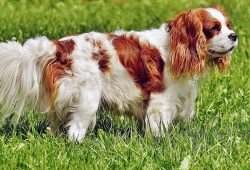The Cavalier King Charles Spaniel is a small spaniel classed as a toy dog by The Kennel Club and the American Kennel Club. It originated in the [wiki title=”United_Kingdom” base=”EN”]United Kingdom[/wiki] and is one of the more popular breeds in many countries. Since 2000, it has grown in popularity in the United States and ranks as the 18th most popular pure-breed in the United States (2013 Registration Statistics). It has a silky, smooth coat and commonly a smooth undocked tail. The breed is generally friendly, affectionate and good with both children and other animals; however, they require a lot of human interaction. Since they are a family dog, it is recommended to not leave them alone at long periods at a time. The expected average lifespan of a Cavalier King Charles Spaniel is under ten years.
Temperament
The breed is highly affectionate, playful, extremely patient and eager to please. As such, dogs of the breed are good with children and other dogs. Cavaliers are not shy about socialising with much larger dogs. They will adapt quickly to almost any environment, family, and location and suit city and country life. Their ability to bond with larger and smaller dogs makes them ideal in houses with more than one breed of dog as long as the other dog is trained. Cavaliers are naturally curious and playful, but also enjoy simply cuddling up on a cushion or lap, making them excellent companion or lap dogs for medical patients and the elderly.
Cavaliers are active and sporting. Cavaliers are successful in conformation shows, obedience and agility and they also make wonderful therapy dogs due to their sweet, gentle natures. The breed is adaptable in their need for exercise, happy with either sleeping on the couch or taking long walks.
Health
Cavaliers can notably suffer from [wiki title=”Mitral_insufficiency” base=”EN”]mitral valve disease[/wiki], which leads to heart failure. This appears in many Cavaliers at some point in their lives and is the most common cause of death. Some serious genetic health problems, including early-onset mitral valve disease (MVD), the potentially severely painful [wiki title=”Syringomyelia” base=”EN”]syringomyelia[/wiki] (SM), [wiki title=”Hip_dysplasia_(canine)” base=”EN”]hip dysplasia[/wiki], [wiki title=”Luxating_patella” base=”EN”]luxating patellas[/wiki], and certain vision and hearing disorders are health problems for this breed. As today’s Cavaliers all descend from only six dogs, any inheritable disease present in at least one of the original founding dogs can be passed on to a significant proportion of future generations. This is known as the founder effect and is the likely cause of the prevalence of MVD in the breed. The health problems shared with this breed include mitral valve disease, luxating patella, and hereditary eye issues such as cataracts and [wiki title=”Retinal_dysplasia” base=”EN”]retinal dysplasia[/wiki]. Cavaliers are also affected by ear problems, a common health problem among spaniels of various types, and they can suffer from such other general maladies as hip dysplasia, which are common across many types of dog breeds.
Cavalier King Charles Spaniel. (2017, July 7). In Wikipedia, The Free Encyclopedia. Retrieved from https://en.wikipedia.org/w/index.php?title=Cavalier_King_Charles_Spaniel&oldid=789404151


